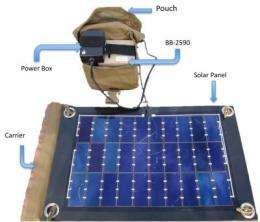NRL charges Marine Corps expeditionary power requirements

Researchers at the U.S. Naval Research Laboratory Electronic Science and Technology Division are working to help the U.S. Marine Corps (USMC) reduce expeditionary energy supply needs and risks and increase the effectiveness of forward deployed forces.
"One of the most significant challenges currently facing the Marine Corps is the need to supply sufficient electricity to individual Marines in forward operating bases," said Robert Walters, head, NRL Solid State Devices Branch. "Mobile photovoltaics are a technology that can address these needs by leveraging emerging, flexible, high efficiency photovoltaic technology."
The military's need to reduce both fuel and battery resupply is a real time requirement for increasing combat effectiveness and decreasing vulnerability. The overarching objective of the USMC Expeditionary Energy Strategy is to increase operational energy efficiency on the battlefield through the combination of on-installation alternative energy production and energy demand reduction. This subsequently is projected to reduce fuel consumed, per Marine, per day, by 50 percent and reduce total weight of batteries carried by nearly 200 thousand pounds.
It has been recognized that photovoltaic (PV) cells are essentially the only renewable energy source that can meet this challenge. NRL, in collaboration with MicroLink Devices, Design Intelligence Incorporated, and the USMC Expeditionary Energy Office (E2O), have developed and prototyped a new photovoltaic system to meet the unique needs of USMC Expeditionary Power for robust, high-efficiency solar panels suitable for adaptation to rechargeable batteries in the field.
The mobile solar power (MSP) prototype, capitalizing on recent advances in solar cell technology that allow the manufacture of high-efficiency, flexible solar cells, consists of an array of single-junction solar cells with a power conditioning circuit that maximizes array power production and charges a standard, military issue, high capacity rechargeable lithium-ion battery (BB-2590).
Flexible solar cells with light to electricity conversion efficiency as high as 30 percent have been demonstrated in multi-cell panels and although field tests are still in progress, initial modeling, simulation, and experimentation of the nearly 150 square-inch deployed array have shown considerable promise toward future progress, producing more than 11 Watts per 1-sun air mass (AM) 1.5 illumination.
Provided by Naval Research Laboratory



















